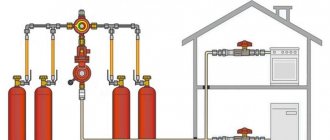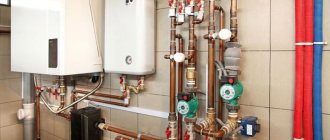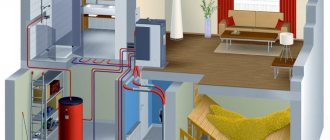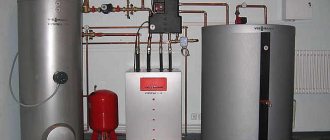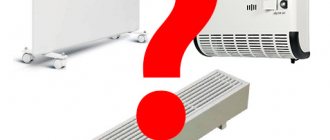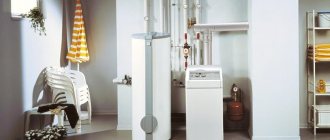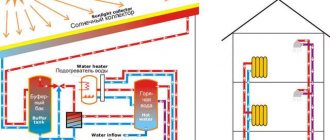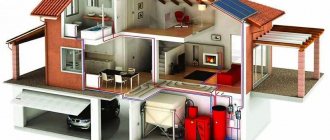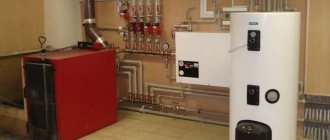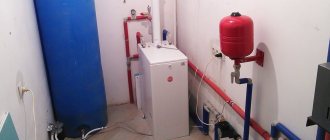Unlike other options for heating a house with electricity, the choice between convectors and an electric boiler is not obvious. It depends not only on the initial parameters of the house, but also on the model of the electric boiler and radiators or electric convectors. A heating system with an electric boiler is more expensive, its installation also requires additional time and money. Standard inexpensive convectors will cost on average 2-3 times cheaper. The theoretical efficiency of both options is approximately 98-99%.
However, the initial cost of organizing heating is only one of the selection criteria. In the article we will look at all the features of using both options, determine what and in what case will be more profitable and efficient, give examples and costs of organizing home heating with an electric boiler and convectors.
Heating the house with an electric boiler
Cases in which heating with an electric boiler is more economical and comfortable are:
- heated area of the house is 100 square meters or more;
- there is an opportunity to purchase an electric boiler in the middle and higher price segment (35-40+ thousand rubles) with advanced automation, the presence or possibility of connecting a room thermostat;
- It is planned to connect a buffer tank to the electric boiler, which will accumulate excess heat.
- Comfort and flexibility of the heating system are a priority.
Compact heating element electric boiler Proterm.
Let's look at each point in more detail.
Firstly , most convectors have a power of 1.5-2 kW and a cost of 2,700-5,000 rubles, this means that for a house with an area of 100 m2 you need 7 convectors of 1.5 kW or 6 of 2 kW (22-25 thousand roubles.).
It is unsafe to connect such a number of convectors through an outlet to a regular power supply, and their total cost is higher than budget electric boilers and almost equal to functional and economical models in the middle price segment. Accordingly, the larger the heated area, the higher the cost of the convector, while the cost of the boiler only barely changes with increasing heating output. But do not forget about the radiator system, if it is not yet organized.
Secondly , standard convectors overheat the air, since their heating elements always operate at full power, turning off when the temperature exceeds the set temperature by 1-2 degrees (it is also worth taking into account the low accuracy of the thermostat. And each additional degree is 3-6% of additional consumption Even the most budget models of electric boilers have at least 3 stages of power adjustment and are able to maintain the set temperature quite accurately and more stably.
The most economical are electric boilers with the presence or possibility of connecting an external room thermostat (issue price is 1-1.5 thousand rubles), for example, the well-known Protherm Skat 9 KR 13 (about 35,000 rubles). In addition to the fact that the operation of the boiler, depending on the room temperature, is more correct and accurate, using a room thermostat you can program operating parameters for the next day or week, for example, reducing the temperature to 15°C during working hours when the owners are not at home.
One of the best models with control via Wi-Fi TEPLOLUX MCS-350 (RUB 5,000-5,500)
Thanks to such operation, colossal savings of thousands of rubles can be achieved. The functionality of a room thermostat is available only in expensive convectors costing from 8-9 thousand rubles.
And thirdly , by increasing the initial costs in order to further recoup, you can supplement the system with a buffer tank - a large tank that accumulates excess heat and subsequently transfers it to the heating system or hot water supply.
The most well-known scheme is the accumulation of as much heat as possible during the nightly (more than 2 times cheaper) electricity tariff, after which the buffer tank will transfer heat to the radiators for another 3-7 hours. A rational scheme is for a large area of the house (especially a frame house), a large reserve of boiler power and the volume of the buffer tank.
It is also worth mentioning that heating system radiators (with the exception of steel panel models with convection fins) do not dry the air in the heated room. However, the installation of an electric boiler with a power of more than 10 kW requires approval from the Energy Supervision authorities.
Efficiency and selection criteria for energy-saving electric heating boilers
Advantages and disadvantages
Let's summarize by comparing the pros and cons of organizing heating with an electric boiler and radiators:
| Advantages | Flaws |
| Greater automation functionality and, as a result, efficiency | Higher initial cost of the boiler and heating system when heating a house up to 100-120 m2). |
| Greater autonomy and stability of the heating system | More complex installation of the boiler itself, organization of piping, installation of radiators |
| Heating system radiators do not “dry the air” | For boilers with a power over 10 kW, a permit is required, as well as 3-phase power and connection via a separate cable |
| At the same time, the issue of hot water supply is resolved | It is recommended to connect to a reliable grounding circuit (similar to grounding a gas boiler); if there is no circuit, this is an additional cost |
| Higher safety, one connection point for the power circuit (as opposed to a group of convectors) | |
| Ease of use: does not take up space in each room, the system has more settings, there is no need to turn on each heating device separately (the temperature in each room can be set using thermostats on the radiators) | |
| Possibility of connecting underfloor heating |
Equipment power
Convector power calculation table.
Many users, when choosing electric convectors, believe that the device that has more power is better. From some perspective this is true, but you need to take into account the operating conditions of the equipment. Heaters can work both as the main heating equipment and as an auxiliary one - functioning when the main heating cannot cope. In accordance with these, the power of thermal equipment is calculated.
To heat an apartment with heating, it is better to choose an electric convector of low power. Focus on the formula - per 10 square meters. m. area needs 0.5 kW of heat. This is quite enough to help the heaters cope with the main heating system. Especially for this purpose, electric convectors with a power of 150 W and higher are available for sale. Thanks to this, you can always choose the most optimal equipment.
If there is no central or autonomous heating in the house, and you plan to create an electric heating system from scratch, then you will need more powerful convectors. Focus on the formula - for every 10 sq. m of area requires 1 kW of heat . Also, do not forget to take into account possible heat losses in your calculations - based on them, leave a margin of 10-20%.
In small country houses, which often lack proper thermal insulation, more powerful heaters may be required - otherwise it will be cold in the interior.
Thus, power calculations are not complicated. To calculate the required parameters, use the tips from our website - we have already written more than once about calculating the heating power for heating rooms, taking into account possible heat losses. If something doesn’t work out for you, or you doubt the calculations, it is best to seek advice from specialists.
What is the difference between heating a private house with electric convectors?
It is better and more economical to use convectors than an electric boiler in the following cases:
- heated area of a private house is less than 80-90 m2;
- it is planned to purchase expensive models with precise electronic control and the ability to combine devices through a common thermostat or application;
- temporary residence in a house when the lower operating costs of an electric boiler do not pay for the high cost of purchasing and installing the entire system.
The most common misconception is that “convectors are more economical than an electric boiler, because during their operation, thermal energy is immediately transferred to the room (convector → air), while the thermal energy generated by an electric boiler goes through the cycle electric boiler → coolant → CO distribution → radiators → air.”
This is true, but it is worth taking into account the previously described factors: more stable temperature maintenance by the electric boiler, the presence of stepwise or even smooth power adjustment, the ability to work based on data from an external thermostat - all this has a much greater impact on efficiency, the difference is confirmed by practice and reviews from owners.
The exception is cases when budget electric boilers with stepwise power adjustment without external control and good convectors in the high price segment (from 8-9 thousand rubles) are compared.
Proper placement and connection of the convector to the electrical network of the country house.
Equipment safety
The best electric heating convectors are those that are equipped with the maximum number of protective modules. We recommend that you pay attention to the presence of built-in security systems, as they directly affect the safety of the users themselves and small children. Let's see what should be on board a safe electric convector:
Pay special attention to the safety of the convector, especially if you have children.
- The rounded shape of the body - it would seem that there is nothing critical about it. But if the edges and corners are rounded, small children playing on the floor will not cause serious injury to themselves . You can grin endlessly and question this fact, but you need to take care of your children - hitting the temporal part of the head on a sharp corner can lead to various troubles;
- The presence of protection against moisture and splashes according to IP 24 - this will allow the operation of electric convectors in wet rooms. For example, if you want to hang heaters in a damp basement or bathroom, it is better to look at models with protection;
- Dust protection is an interesting option, useful not only for allergy sufferers, but also for healthy people. It's no secret that electric convectors (like any other) raise dust into the air, which spreads throughout the rooms. It affects human health, and heaters with dust filters allow you to trap dust particles and keep them inside;
- Fall protection – provides protection for equipment and interior items from overheating and fire if equipment is accidentally dropped on the floor;
- Overheating protection – pursues the same goals as in the previous paragraph;
- Frost protection – prevents freezing of rooms and buildings at times when no one lives there. In this case, electric convectors maintain the air temperature at +5-6 degrees.
You should also pay attention to improved electrical protection - it is best to have it, as it ensures the safety of users.
What is ultimately more economical and efficient: electric boiler or convectors
As mentioned earlier, the choice depends on the area of the private house and the model of electric boiler/convectors.
For a house with an area of 40-80 m2, you can safely choose 2-4 convectors with a power of 2 kW each, the total cost of the solution will be about 5,500-10,000 rubles. + organization of separate wiring for their power supply, because It is simply unsafe to turn on devices of such power for a long time and is fraught with constant overloads.
The minimum costs for organizing heating will cover operating costs that are 5-20% higher for many years to come. With a larger budget, in order to increase efficiency and operating comfort, you can pay attention to the more expensive models Noirot, Electrolux, Ballu or Nobo.
For houses with an area of 80-120 m2, the choice is still not obvious, since the total cost of convectors is already closer to the cost of organizing a heating system with an electric boiler and radiators, and the advantages of good electric boilers are already obvious.
For houses with an area of 120-300 m2 or more, it is better to use an electric boiler. The heating system will be more stable, the savings due to control through an external room thermostat will be extremely noticeable, the connection of a powerful electrical appliance will be carried out at one point, you can easily solve the issue of hot water supply, connect heated floors, rationally use the buffer tank.
How to accurately calculate the required boiler power Individual calculation, formula and correction factors
Types of heating elements
Heaters with open heating elements burn oxygen.
In electric convectors there can be both open and closed heating elements. Open heating elements are distinguished by the fact that they display a heated coil of high-resistance wire. It is best not to buy such devices, since they can burn oxygen, and the reliability of such heating elements is called into question - under the influence of oxygen in the air and the moisture contained in it, the spiral can fail, collapsing due to corrosion.
It is best to take a closer look at electric convectors with closed heating elements. Here the spiral is located inside a tightly sealed metal tube, on top of which we see metal fins. Such heating elements do not burn oxygen and are much less likely to fail without succumbing to corrosion . Today they are used in the vast majority of electric convectors.
We can also recommend electric convectors with monolithic heating elements made in the thickness of artificial stone. They are better in that they have an increased service life, and the stone itself allows you to retain accumulated heat for a long time, gradually releasing it to the air.
Comparative table of the cost of organizing heating
| House area, m2 | Heating method | Manufacturer and model | Total cost, rub. | Price of 1 kW of thermal power, rub. |
| 60 | Electric convectors | Ballu BEC/EZMR-2000 (3 pcs.) | 3 000*3 = 9 000 | 1 500 |
| Electric convectors | REDMOND SkyHeat C4519S (3 pcs.): el. control, connection and programming via app | 9 600*3 = 28 800 | 4 800 | |
| Electric boiler and radiators | Protherm Skat 6 KR 13 + Rifar Base 500 x6 (4 pcs.) + harness | 32 000 + 4 200*4 + 5 000 = 53 800 | 8 966,6 | |
| 100 | Electric convectors | Ballu BEC/EZMR-2000 (6 pcs.) | 3 000*6 = 18 000 | 1 800 |
| Electric boiler and radiators | Protherm Skat 12 KR 13 + Rifar Base 500 x6 (9 pcs.) + harness | 35 000 + 4 200*9 + 6 000 = 78 800 | 7 880 | |
| 150 | Electric convectors | Noirot CNX-4 1500 (10 pcs.) | 6 300*10 = 63 000 | 4 200 |
| Electric boiler and radiators | Vaillant eloBLOCK VE 18 Rifar Base 500 x6 (13 pcs.) | 39 000 + 4 200*13 + 9 000 = 102 600 | 6 840 |
As you can see from the table, the larger the area of the house, the higher the cost of each kW of thermal energy obtained when heating with convectors and the lower when heating with an electric boiler. At the same time, the advantages and efficiency of an electric boiler are obvious.
BoilersHeatersElectric boilers
Design
Electric convectors are equipped with durable housings with outlet openings. The design of the cases can be either simple or more expressive. By producing electric convectors, manufacturers strive to give their customers the opportunity to purchase equipment of any kind. Thanks to this, the following are available for sale:
- Electric convectors with specially shaped housings;
- Devices with unusual colors;
- Electric heaters finished with decorative materials.
Glass convectors look great in the interior.
Models with front tempered glass look best . The glass itself can be black, white, gray, colored and mirrored. Often some drawings or abstractions are applied here.
Designer electric convectors are ideally suited for rooms in good repair. They can be mounted both under windows and along blank walls, delighting consumers with their excellent appearance. Some models differ significantly in their cost, but this is typical for all not the most ordinary equipment.
Glass electric heaters look best indoors. They work due to a heating element made of glass, inside of which there is a conductive gel or conductive spray. These devices are quite expensive, but they look just great. Some modifications are made on the basis of mirror glass, resulting in combined units - they combine heating appliances and bathroom mirrors.
Location of convection holes
Rarely does anyone pay attention to this little detail, although it would be worth it. The holes can be located on the top, sides and front.
The most rational solution in terms of air mass circulation will be the location of the terminals on top of the narrow part of the housing. However, this leads to dust getting inside. It causes an unpleasant burning smell and can damage the device.
Also, in such models it is worth abandoning wall placement. Otherwise, the wallpaper or paint will change color after some time. With this method of fastening, it is advisable to choose objects whose openings are located on the facade.
Purchase
We hope the article helped you decide which convector to buy for your home, and which one is more appropriate to choose for your dacha .
Another important aspect of a profitable purchase is the answer to the question where to buy a convector ? Give preference to trusted stores that can guarantee the quality of the product offered! This will protect you from counterfeits and troubles associated with low quality goods. We wish you a cozy microclimate in your home and warmth in your soul at any time of the year! The personal opinion of one of the users regarding how to choose an electric convector can be seen here:
Principle of operation
The operating principle of this heating device is simple. Cold air is heavier than hot air and accumulates at the bottom. Warm air, accordingly, is lighter and tends to rise. The convector has two holes - bottom and top. Cold air enters the lower hole, is heated there with the help of a heating element and, having gained temperature, begins to rise, exiting through the upper slot.
The design of the device is also simple. There is a heating element located inside the housing. The heating temperature is set by a thermostat, the regulator of which is located outside. The equipment works from the network. Convectors are most often made of metal 0.8 mm thick.
Functions
These features include safety options and additions that make the operation of the equipment more comfortable.
- Overheat shutdown – when critical temperatures are reached, heating stops.
- Tip-over sensor – important for floor-standing models as it prevents fire. If the unit falls, the shutdown mechanism will operate.
- Anti-freeze – useful if you leave the device in a cold room. In this case, the temperature is automatically maintained at 5-7 degrees. And the equipment itself will not freeze, and you can restore comfortable levels in the room quite quickly.
- Timer – allows you to delay turning off and set the turn on at the desired time.
- Child protection - control panel lock.
- Restart – memory of the last settings. Useful for restoring operation with specified parameters after a break or during a power outage.
- Remote control – implies the presence of a remote control or pairing with a smartphone through a special application.
- Ionization is the saturation of air with useful negatively charged ions. Although caution is required here: not everyone is allowed to use an ionizer and not always.
- Humidification - optimal humidity parameters are 40-60 percent, but due to heating devices they are reduced. And this is fraught with negative consequences for health.
How to choose a convector
All of the above models differ from each other in a number of parameters. In particular, in terms of power, installation method, safety, warranty period and others. Today, the convector market is significantly overcrowded. Making the right choice with such variety is quite problematic. To understand all the intricacies, KP turned to the founder and host of the YouTube channel “A Man in the House” Alexei Tretyakov . Every week he films reviews about the features of living in a country house. Alexey knows from his own experience what choosing a convector means.
Wall or floor
According to Alexey, first of all you need to determine for yourself the desired method of fixing the heater. In most cases, they are installed under the window on a special bracket. Sometimes buyers want to make the heater mobile. To do this, you should purchase special legs with wheels, if these are not provided in the kit.
Frame
Particular attention should be paid to the body of the device. The material from which it is made and the dimensions are important. The convenience of placing the device and its convective properties will depend on the last parameter. Thus, at a height of 0.4-0.6 m, heaters have the highest draft and heating. If this parameter is 0.2-0.4 m, then heat removal is significantly reduced, but this is compensated by the width of the device. The lowest heat flow rates are typical for convectors with a height of 0.15-0.2 m
Manufacturers
Convectors are produced by many domestic and foreign companies. The ranking of the top five manufacturers is as follows.
- Noirot is a French brand that has been on the market since 1938. Excellent quality and thoughtful design allow its products to remain among the best.
- Ballu is a transnational company present on the Russian market since 2003. It has in its assortment both budget samples and complex design equipment.
- Nobo is a Norwegian company operating since 1928. These are highly reliable products with a service life of at least 20 years.
- Stiebel Eltron is a manufacturer from Germany, whose products have been sold on the domestic market for more than 25 years. Now it is an international group of companies and one of the recognized leaders in the field of heating and water supply.
- Timberk is a Swedish brand that has been actively developing since 2003. It offers a wide range of household equipment, including heaters.
Of course, this is not a complete list of companies that produce reliable and high-quality designs. There are also such domestic brands as: Kalashnikov, “Breeze”, KZTO, STN and others. The top five did not include good European brands: Arbonia, Electrolux, Buderus, Kermi, Purmo, Zehnder.
Thermostat
It is needed to maintain the exact temperature set by the user. It is enough to set the desired parameter once, and the equipment itself will regulate the work according to the specified settings.
The most familiar and understandable is the mechanical thermostat. It is based on a thin plate. It is very sensitive to changes in temperature and arches in response to its increase. When the set value is reached, the electrical circuit opens and the operation stops. As soon as the plate begins to cool and return to its original position, the energy supply is resumed.
This mechanism guarantees accuracy up to 1 degree. Operation is accompanied by characteristic clicks, which is very annoying, especially at night.
The electronic element has a more complex mechanism. It allows measurements with an error of less than 0.1 degrees. Here, electricity consumption is reduced by up to 10% and there are no extraneous sounds. However, such samples are more expensive and more difficult to repair.
